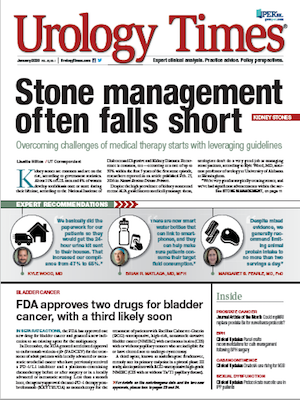Publication
Article
Urology Times Journal
Panel crafts recommendations for cath management following BPH surgery
Author(s):
An expert multidisciplinary panel using robust methodology has developed recommendations for guiding urinary catheter management after transurethral surgery for BPH.
sveta - stock.adobe.com

An expert multidisciplinary panel using robust methodology has developed recommendations for guiding urinary catheter management after transurethral surgery for BPH.
As described in a recently published article (Am J Manag Care 2019; 25:e366-372), the group agreed that the catheter should be removed approximately 24 hours after uncomplicated transurethral surgery and that prolonged catheterization should be avoided in the event there was no clinically significant perforation sustained at the time of surgery.
“Transurethral surgical management of BPH is one of the most common procedures done by urologists, and although there are guidelines with regard to treatment choice, there are none to inform the duration of catheterization postoperatively,” said co-author Casey A. Dauw, MD, assistant professor of urology, University of Michigan, Ann Arbor.
Read: New data point to statins’ potential for reducing prostate growth
“Our group has addressed this gap using the RAND/UCLA Appropriateness Method that couples scientific evidence with expert clinical judgment to develop what we believe are valid recommendations that will be clinically useful for urologists. In addition, we believe that our recommendations will be helpful for payers and patients because by promoting timely catheter removal, they can minimize the downstream complications associated with urinary catheterization and the negative impact it has on quality of life.”
Lead author Ted Skolarus, MD, MPH, assistant professor of urology, University of Michigan, told Urology Times, “It seems the robust methodology used to develop these recommendations, coupled with the lack of guidelines to postoperative catheter duration, should facilitate their implementation into routine practice with the ultimate goal of improving the consistency and quality of care for patients undergoing transurethral surgery for BPH.”
The RAND/UCLA Appropriateness Method has been used to define appropriate care in various clinical areas, including for active surveillance of prostate cancer, and has been shown to be predictive of results of subsequent randomized controlled clinical trials. It includes a systematic literature review to identify relevant articles and a clinician panel rating process.
Next: Four clinical scenarios evaluatedFour clinical scenarios evaluated
The recommendations on catheter management after transurethral surgery for BPH were developed considering 42 published articles reporting outcomes for transurethral resection or ablation. The panel members were given a summary of the articles and asked to consider the evidence and their clinical judgment to rate the appropriateness of five different durations of catheterization (postoperative day 0, 1, 2, 3-6, or ≥7) across four clinical scenarios: no preexisting catheter; preexisting catheter, including intermittent use; difficult catheter placement in the operating room; and clinically significant perforation.
The 11-member expert panel was comprised of eight urologists, two nurses who care for urologic patients, and an infection disease physician with expertise in urinary tract infections. There was consensus among the panel members that urethral catheter removal with a voiding trial should be done on the first postoperative day in the first three scenarios and that it was inappropriate to wait ≥3 days to remove a catheter for a first voiding trial in those situations. In cases of clinically significant perforation, waiting until 3 days after surgery was deemed the appropriate timing for catheter removal.
Also see: Data from 18-year study support HoLEP’s efficacy
The panel members were also asked to rate the appropriateness of intermittent straight catheterization and indwelling urinary catheter placement after a failed first trial of void, including time to a second trial of void.
“Ratings on management for those scenarios were more variable, and decisions in practice will be guided by individual clinicians’ judgment,” Dr. Dauw said.
“However, the panel concluded that both intermittent straight catheterization and indwelling catheter placement were acceptable management approaches for patients who failed a first voiding trial and that the next trial of void should be within 1 to 2 days for hospitalized patients and within 4 days for patients who had been discharged home.”































